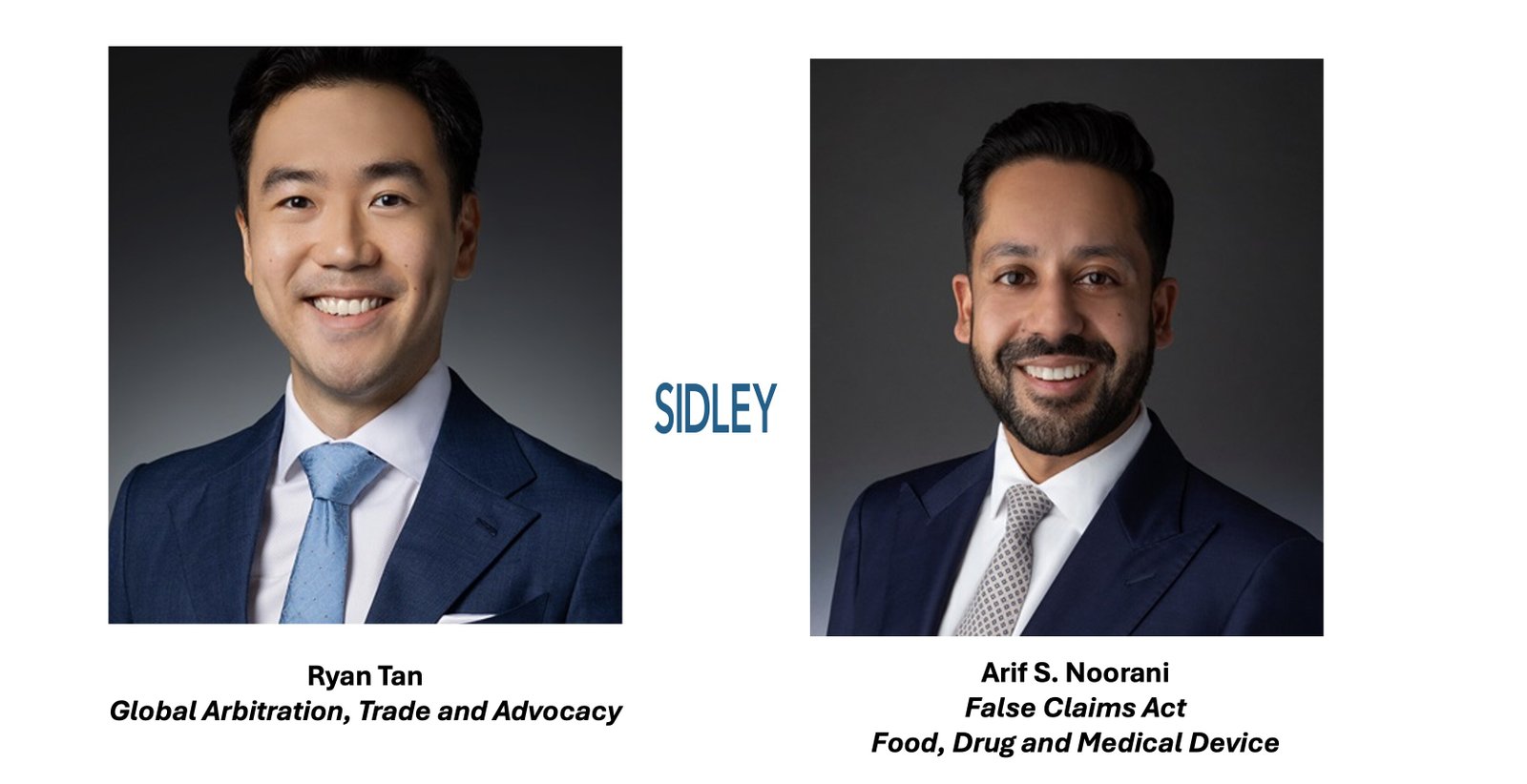India’s Life Sciences Industry Faces a Defining Moment Amid Shifting U.S. Drug Policies and Regulatory Scrutiny
25 June 2025 | Wednesday | Opinion | By Sidley Austin partners Arif S. Noorani and Ryan Tan

India’s life sciences industry has grown at a remarkable pace over the past two decades, transforming into a global manufacturing powerhouse. Indian pharma, biotech and medtech companies play a pivotal role in supplying a significant portion of affordable, high-quality medicines to the U.S. market. This is particularly true in relation to generics, biosimilars, low-cost vaccines, and active pharmaceutical ingredients (APIs).
In the first few months of the current U.S. Administration, a series of executive orders were issued that were aimed at reducing prescription drug prices and reviving “America First” policies in pharmaceutical manufacturing. While much of the focus has been on U.S. companies and patients, the orders carry significant implications for the global life sciences sector, with perhaps the greatest consequences for India, given its outsized role in global generic drug supply. The myriad policy changes offer both opportunity and increased scrutiny for Indian drug manufacturing, and they shed light on proactive steps manufacturers can take in anticipation of these developments. New efforts to accelerate approvals for low-cost alternatives may expand market access, but parallel moves to intensify FDA oversight, revise trade arrangements, and boost political accountability are reshaping the regulatory environment.
Executive Orders and FDA Actions Prioritize Generic Drugs and Cost Reduction
Three recent executive orders underscore the Administration’s dual goals of reducing costs and reshoring pharmaceutical production. These policy decisions are set to ripple across Indian drug manufacturing hubs from Hyderabad to Ahmedabad—potentially reshaping market access, pricing models, and compliance obligations.
- Accelerating Generic and Biosimilar Approvals: The FDA has been directed to issue recommendations by October 2025 to speed the review and approval of generics, biosimilars, combination products, and second-in-class brand drugs. A separate initiative aims to facilitate the reclassification of certain prescription drugs to over-the-counter status. Indian firms, already global leaders in complex generics, may gain a competitive edge if they can capitalize on these regulatory shifts faster than U.S. peers.
- “Most-Favored-Nation” (MFN) Pricing Targets: Another executive order seeks to tie U.S. drug prices to those paid in other developed nations. If “significant progress” is not achieved, agencies are instructed to consider actions ranging from importation and pricing controls to the revocation of product approvals. For Indian manufacturers, the MFN model creates new risks and opportunities—they may benefit as preferred suppliers of competitively priced drugs, but they could also face increased scrutiny regarding pricing practices and regulatory compliance.
- Regulatory Relief to Promote Domestic Production of Critical Medicines: An executive order dated May 5, 2025, directs HHS, FDA, EPA, and other agencies to streamline permitting, environmental, and regulatory review processes for pharmaceutical manufacturing in the United States. The order aims to eliminate duplicative rules and accelerate the development and approval of domestic pharmaceutical facilities and infrastructure. Notably, it also reinforces the Administration’s support for more aggressive oversight of foreign facilities, requiring the FDA to publish foreign inspection data and enhance its risk-based inspection model funded by higher foreign facility fees. This is particularly relevant for India, which accounts for the largest number of FDA-registered overseas facilities supplying the U.S. market. Simultaneously, the FDA is also undergoing a review of existing policy to provide clarity with the goal of reducing the amount of time it takes to get a new domestic pharmaceutical manufacturing facility operational.
Meanwhile, as part of an ongoing effort to facilitate the development of generic drugs, the FDA has released updated guidance documents for dozens of products that treat a range of conditions (e.g., asthma, allergic reactions, pulmonary disease). The guidance documents clarify the requirements for generic drug applications, and many are aimed at supporting the development and approval of complex generics, which are typically more difficult to replicate than standard small-molecule drugs. In particular, the guidance documents provide detailed recommendations on demonstrating bioequivalence and product sameness, which are critical for generics to gain approval.
At the same time, the FDA has recently dismantled—and purportedly rehired—personnel in its Division of Policy Development, including a team of 13 seasoned experts responsible for crafting guidance on generic drug development, and it is unclear how frequently new guidance for generic drug development will be circulated by the agency. With deep experience in developing complex generics and a cost advantage in formulation science, Indian manufacturers are uniquely positioned to benefit—provided they move swiftly to align with the FDA’s expectations and navigate any regulatory ambiguity that may arise from recent internal agency restructuring.
Lawmakers and FDA Continue to Raise Alarms About Foreign Manufacturing Drug Quality
On Capitol Hill in Washington, D.C., recent letters from Congress—one to the FDA, and one to the Office of the United States Trade Representative and the U.S. Department of Commerce —as well as recent announcements from the FDA reinforce the U.S. Administration’s evaluation of America’s dependence on foreign manufacturing. Citing risks to national security and patient safety, lawmakers highlighted:
- 80% of APIs used in U.S. drugs come from India and China.
- More than 50% of drug manufacturers that are supplying the U.S. market operate overseas.
- Nearly 70% of medical devices sold in the U.S. are produced entirely abroad.
The letters also underscored a number of issues being identified by the FDA during inspections at foreign manufacturing facilities, such as contamination incidents, falsified data, and lapses in sterility. Congress has repeatedly urged the FDA to apply the same level of inspection scrutiny to foreign firms as it does domestically. On May 6, 2025, the FDA announced plans to expand the use of unannounced inspections at foreign facilities—a major development for all international manufacturers, including Indian companies. This move builds on the agency’s India- and China-specific pilot program and aligns with the U.S. Administration’s broader directive to align the regulatory standards between U.S. and foreign sites. FDA Commissioner Martin Makary made the agency’s new posture clear:
“For too long, foreign companies have enjoyed a double standard—given advanced notice before facility inspections, while American manufacturers are held to rigorous standards with no such warning. That ends today.”
The expanded program will seek to complete a number of primary objectives: (1) cut advance notice to foreign sites, (2) shorten foreign inspection trips, and (3) be funded in part by increased facility fees for overseas manufacturers. Indian manufacturers of generics and biosimilars are likely to see increased demand if they can meet U.S. quality and compliance standards during inspections, particularly surprise inspections that may carry more weight and credibility with Congress and the FDA.
The previous surprise inspection pilot program resulted in increased import alerts, warning letters, and delayed approvals for noncompliant facilities in India and China. It is therefore likely that enforcement will see a similar uptick during the upcoming expansion of unannounced inspections. Because the FDA already has an established office in New Delhi, logistical readiness may allow the agency to ramp up inspections more quickly than elsewhere—making Indian manufacturers potentially an early focal point.
Trade Barriers Loom Over Indian Exports
India exports billions of dollars in pharmaceuticals to the U.S. alone, making the country one of the most exposed global suppliers in the event tariffs are implemented. Although pharmaceuticals have so far been exempted from most of the new U.S. tariffs—and tariffs are being actively scrutinized by U.S. courts for their legality—the Commerce Department is investigating the national security implications of pharmaceutical imports. According to the notice, the goal of the investigation into pharmaceuticals is to “determine the effects on national security of imports of pharmaceuticals and pharmaceutical ingredients, and their derivative products. This includes both finished generic and non-generic drug products, medical countermeasures, critical inputs such as active pharmaceutical ingredients and key starting materials, and derivative products of those items.” While similar security investigations in recent years have taken over eight months to complete (270 days), the Administration has publicly stated that it intends to move more quickly on its review of pharmaceuticals and other essential FDA-regulated products.
As the world’s largest producer and exporter of generic drugs, Indian manufacturers could face potentially significant cost increases from the imposition of pharmaceutical tariffs. Companies may be forced to consider temporarily exiting the U.S. market.
At the same time, any planned tariffs on drugs or other medical products could cause shortages of low-cost, critical drugs or render certain products financially infeasible. This would likely drive up costs for patients—not lower them—which is one of the government’s primary objectives.
What Indian Manufacturers Must do to Stay Competitive and Compliant
To remain competitive and compliant amid rising expectations, Indian life sciences manufacturers should:
- Conduct surprise mock inspections and establish continuous inspection readiness—assume the FDA may arrive unannounced at any time.
- Reinforce and invest in data integrity systems and quality management systems across operations to build trust with U.S. regulators and lawmakers.
- Monitor tariff policy developments and model product-line impact scenarios, including existing supply chain and manufacturing arrangements.
- Evaluate diversification strategies, including the feasibility of alternative locations for global operations, including investing in U.S.-based joint ventures, local production, or acquisitions.
- Engage early with U.S. regulators and congressional allies to educate and align on policy objectives and foreign manufacturing quality considerations.
Most Read
- How Health Systems Are Reshaping Drug Adoption, Partner Models, and Market Access in 2026
- Top 25 Biotech Innovations Redefining Health And Planet In 2025
- The New AI Gold Rush: Western Pharma’s Billion-Dollar Bet on Chinese Biotech
- Top 25 Biotech & Biopharma Leaders in Sustainable Innovation, 2025
- China’s Biopharma Dealmaking Surges in H1 2025, Driven by Record Licensing and Oncology Focus
- Chikungunya in China: How a “Forgotten” Arbovirus Found the Perfect Storm
- How Innovation Gaps in Biopharma Raise New Safety Concerns
- Smart Implants and the Future of Musculoskeletal Injury Treatment
- How Ethical Gaps in Psychiatry Could Undermine Biopharma Progress
- The Evolving Landscape of Women’s Health Innovation in the Asia-Pacific
- Using NLP-Driven Decision Support in Emergency Health Assistance
- Taiwan Steps Into the Global Spotlight With a New Cancer Therapy
- The Role of Unique Device Identification (UDI) in Tracing Medical Device Safety
- The Importance of a Patient’s Mental Health During Clinical Trials
Bio Jobs
- The State of Biotech and Life Science Jobs in Asia Pacific – 2025
- Avantor’s New CEO Ligner Aims to Unlock Global Potential and Deliver Shareholder Value
- AstraZeneca Commits $50 Billion to U.S. Expansion by 2030 in Biggest-Ever Global Investment
- Thermo Fisher, SAMRC, and South Africa’s Department of Science and Innovation Launch CATIR to Nurture Next-Gen Scientists
- Cube Biotech Appoints Former Sartorius CEO Dr. Joachim Kreuzburg to Board of Directors
- FDA’s AI Transition Marks a Turning Point in Drug Review: Industry Faces Pressure to Adapt Amid 20% Workforce Cut
- WuXi XDC Completes Mechanical Build of Singapore Bioconjugate Manufacturing Hub
News
Editor Picks











